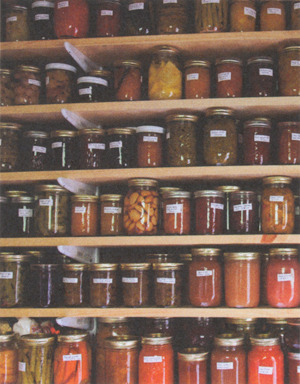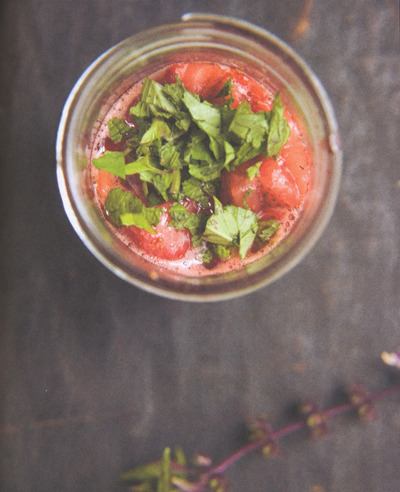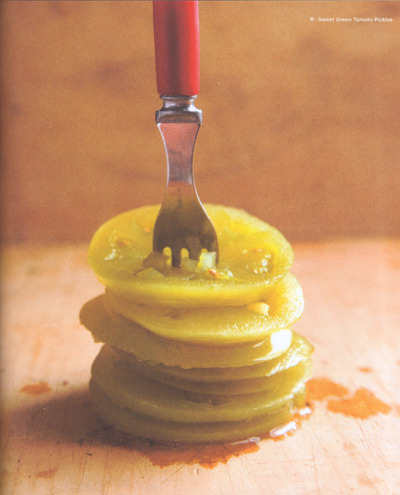Canning for a New Generation
Best modern canning guide
This is not your grandma’s canning book. Preserving is not really cheaper, nor is it a survival and disaster remedy. Canning these days makes sense as a culinary endeavor — because you can make preserves that taste better, or are far more varied than anything you can buy. This book is the best of a bunch of new guides on modern canning techniques and recipes (like Put ‘Em Up, which is decent but not as good). I prefer the recepies in Canning for standard items like james and jellies because it calls for far less sugar than other books, and it has a wide range of culinary influences. The book is also intelligently and simply designed with beautiful illustrations of the preserved treasures.
04/6/12Excerpt
When I was growing up, canning was for old folks and cranks and separatists --oh, and for my parents, who spent every summer of my Virginia childhood scrambling to convert overflowing bushel baskets of fruits and vegetables from their garden into a pantry lined with shelf upon shelf of colorful canning jars, not to mention a stuffed-to-the-rim chest freezer or two. Not for me. I had better, far more important things to do. I can't remember what they were.
*

*
For me, putting up the very best produce I can find in season--especially if it's homegrown or from a nearby farm--is quite simply a way to spend some marginally productive time in the kitchen, preferably with my family and friends. Opening the jars and enjoying them later, I'm reminded of those fun times of tasting and talking, usually about food but also about music and politics and everything else that matters. In addition, taking on a kitchen project of a certain complexity, like canning or pickling or fermenting (or smoking meat or stuffing sausage or aging cheese), helps me remember what food was like when I was a kid and my mom and dad did these things, and what it might have been like when they were kids.
*
Low-sugar jams and preserves
The jams and fruit preserves in this book are all quite low in sugar, simply because I think looser, less-sweet spreads taste better than sticky, cloying ones. Most contain fresh lemon juice, which is added primarily for flavor but also to up the acid content a bit. The jams and preserves have a remarkably intense fruit flavor because excess water is cooked out rather than gelled with store-bought pectin.
*
Real pickles
Here you'll find everything from refrigerator pickles in vinegar brines that will last a few weeks or months in the fridge and don't need any processing, to canned quickly brined pickles that will last a year in the pantry, to long-fermented pickles made sour by fermentation, to Indian and Middle Eastern-style "pickles" such as citrus preserved in salt. Most pickles are low in sugar, but not low in salt (which I fervently adore) or delicious tanginess, whether it's that sharp bite of the acetic acid in vinegar or the mellow tang of fermentation-produced lactic acid.
*
So there you go. Heating to kill off existing microorganisms, processing to create a vacuum and prevent introduction and growth of microorganisms, and using high-acid foods or acidulating those that are not in order to create an acidic environment that's inhospitable to microorganisms.
*
Quick, High-Yield Strawberry Jam: Makes about 7 half-pint jars
Here's a basic jam recipe that uses Pomona's Universal, a commercial sugar-free low-methoxyl natural pectin derived from citrus rinds. It can be used in low- or even no-sugar recipes because it's activated by calcium rather than sugar. You can adapt it to just about any fruit. If what you want is a lot of jam from not a lot of fruit (say, if you're making a big batch to give as gifts), and if you want to cut back dramatically on the sugar content, this is the way to go. This jam, while not as intensely fruit-flavored as the no-commercial-pectin preserves in this book (here you're essentially gelling the water that in other recipes is cooked off), will be thick, semi-firm, and light--a refreshing jam, if you will allow that such things exist. Pomona's Universal can be found at health-food stores or online (see Sources, page 291).
*

Strawberry Jam with Thai Herbs: Makes about 4 half-pint jars
This is a sweet-tart preserve, but the mineral cilantro, fragrant thai basil, and fresh mint give it a complexity reminiscent of a good, well-balanced yum, or thai salad. Strawberries pair so well with herbs, and indeed all sorts of crazy savor things--balsamic vinegar with strawberries being one surprisingly long-lived trend--that it didn't take much to come up with this extraordinary jam. Try this: Go out into the herb garden with a plate piled with halved berries and a little mound of sugar. (Or gather a bunch of leftover herbs from the refrigerator, or befriend a generous herb grower.) Dip a berry in the sugar, and pop it in your mouth with a few leaves of different herbs, tasting and tasting until you come up with a combination you like. It'll be a little different from the actual jam, of course, but you'll be able to tell if you'll like the finished result.
*

Canning for a New Generation Liana Krissoff 2010, 304 pages $15






